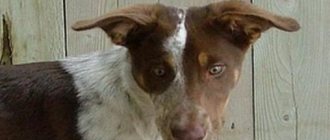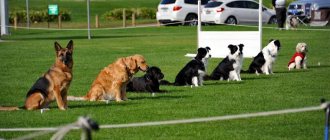At what age do you start training?
Puppy training must begin from the very first days
the presence of a dog in your home. Because already from infancy, the puppy must learn the rules of behavior in your house, what is allowed and what is forbidden, how to behave with all family members, even the smallest and oldest, what he can play with and what he can’t, where to go. toilet and much more.
And we are talking, first of all, about the proper upbringing of an American Staffordshire Terrier puppy, and you can start training and learning commands when the puppy is completely comfortable in your home. As a rule, one week is enough. By this time, the puppy is already filled with curiosity and is diligently exploring the world around him. If, after this time, the puppy remains fearful and does not make contact well, then it is better to seek help from a dog handler-animal psychologist, because This behavior is not typical for puppies of this breed.
When can you start training with a dog handler?
The beginning of the puppy's training coincides with the time of the first exit to the street. When the first two vaccinations have already been done, the quarantine (lasts 7-14 days, depending on the vaccination) after them is over. It is not at all necessary to train your puppy only outside; the first sessions are best done at home, where there are fewer distractions.
Often new puppy owners worry that training from the first days will be excessively stressful for the dog. This is only possible if outdated, rigid methods are used, and with the right approach, training from the first days will, on the contrary, be very useful, since it allows you to immediately establish contact
with the puppy and build a trusting relationship.
You can start raising a puppy from the first days of its appearance in your home, and training and classes with a dog handler can begin simultaneously with the start of walks, when quarantine ends after the second vaccination.
Why you don't need to wait up to 6 months
You often hear that American Staffordshire Terriers, like other dogs, cannot be trained before 6 months, because training is stressful. This opinion remains from the times of outdated methods based on cruel coercion and intimidation of the dog. Unfortunately, there are still plenty of dog handlers using similar techniques today. But fortunately, science does not stand still and modern techniques make it possible to train a puppy from the first days in a new home. Therefore, you should not wait until your American Staffordshire Terrier puppy has established unwanted behavior; you can start training much earlier.
Training at 2 months. Upbringing
At 2 months old, your American Staffordshire Terrier puppy is still at home, in quarantine after the first vaccinations, and he is not yet allowed to go for walks. Therefore, it’s time to start raising a puppy in the home conditions that are already familiar to him.
Toilet training
The first step is teaching the puppy to go to the toilet in a diaper . You should not rush to teach going to the toilet directly outside, bypassing this stage, because puppies are not physiologically ready for walking twice a day. This ability is developed in American Staffordshire Terrier puppies no earlier than 6 months, and in some up to 1 year.
It should be remembered that any learning is a rather complex thing and, seeing the first positive results, you should not think that your puppy has already understood everything, but you should continue training according to the method, so that after a while you do not have to start all over again.
Collar and leash training
The second important point will be to accustom the puppy to a collar and leash . Yes, yes, this should be done at home, so that by the time the puppy goes outside for the first time, wearing a collar will not be additional stress for him, but is already a familiar thing, and he can start exploring the world around him, rather than trying to get rid of an unknown object.
What to allow a puppy and what not
The third point, which causes the greatest difficulty for new puppy owners, will be determining the puppy’s boundaries of what is permitted. Often, many novice dog owners think that the unwanted behavior of an American Staffordshire Terrier puppy will “go away on its own, outgrow it.” But, unfortunately, the behavior that is allowed for a puppy will be taken for granted later by an adult dog.
.
Any unwanted behavior in a puppy WILL NOT go away on its own, but will only become stronger over time.
Therefore, it is necessary to start defining the puppy’s boundaries of what is permitted now. You will need:
- Teach to play only with your toys, and not with your things;
- Explain that you cannot bite your hands even in a game;
- Establish the correct daily routine, establishing the rule that in the morning you need to sleep and not wake you up;
- Stop chewing furniture, clothes, walls and baseboards;
- Teach to stay home alone, knowing that your absence is not a reason to bark or howl.
IT IS EXTREMELY IMPORTANT TO KNOW: constant and excessive punishments that follow almost every action of the puppy have a detrimental effect on his fragile psyche and can lead to the fact that the American Staffordshire Terrier puppy grows up cowardly and embittered. For normal natural development, a puppy must have the opportunity to explore the world around him, which is currently limited to your apartment or house.
Introduction to Basic Commands
Already now you should begin to familiarize yourself with the initial obedience commands in a light playful form, while focusing on rewards for execution, because the puppy’s psyche is still quite plastic and excessive severity and exactingness can lead to the puppy being intimidated and cowardly. Therefore, it is necessary, first of all, to try to interest the puppy by offering him a toy or treat, and sometimes just praise.
How to start right
Education begins with the process of socialization. First you need to teach your baby:
- To his new nickname;
- To the place where he will sleep;
- Collar and leash.
Kids quickly get used to new things and explore the world with interest. If a child behaves eccentrically, it is enough to send him to a place where he will have to be left alone for some time.
If you punish a dog, then the moment he goes home, you can no longer touch him or scold him. His place is his fortress, where he must know for sure that he is protected from the outside world.
It is better to separate a place for sleeping and where the puppy will eat; his bowls should be in only one place, and he should eat at the same time. Moreover, people in the family eat first, and then animals. Adult pets also eat first, all in order of seniority. From a very early age, teach him that begging is prohibited and do not give him pieces while you are at the table.
Walks
After your baby has learned his name and settled into his new home, start going outside wearing a collar and leash. Walks should not be long, preferably if you go out not only along one route, but also in new places. During this period, the puppy should begin to get used to it, not only to walking, but also to the outside world. He must get used to:
- Loud sounds;
- Machines;
- To strangers;
- Other animals.
Be careful if you let him off the leash until he has mastered the basic commands, he will definitely not obey. It will be difficult to catch him, most likely he will think that you are just playing with him and will not approach.
Training at 3 months. Socialization
Three months is an important stage in an American Staffordshire Terrier puppy’s introduction to the outside world. Your first walks should be short and not too tiring for the puppy. You should start with 15 minutes, gradually increasing the walking time to 1 hour.
Correct formation of the nervous system
At this age, the puppy’s nervous system is forming.
. It has been proven that raising puppies in isolation during this important period contributed to the development of pronounced cowardice in them later. It is necessary to show the puppy as much as possible: noisy streets, large crowds of people, etc. Everything that he will have to face in later life.
This must be done very carefully, gradually, over and over again increasing the time spent in noisy places, so as not to overload the puppy or frighten him.
The territory of a country house, cottage or village are places with a minimum amount of external stimuli for a city dog. Therefore, if you plan to keep a dog in an urban environment, “growing up” an American Staffordshire Terrier puppy in such conditions depleted of irritants is unacceptable.
A city puppy must grow up in the city, in conditions that are saturated with external stimuli, such as: noisy streets, large crowds of people, other animals, birds, cyclists, cars, etc.
Meeting people and dogs
It is necessary to introduce the puppy to friendly dogs and people
so that later the puppy does not develop aggression or cowardice caused by the fear of new things and the inability to communicate and make new acquaintances. Currently, unfortunately, this is not uncommon in the behavior of adult dogs, but a fairly common problem with which people turn to our specialists for help.
Puppy behavior on the street
The emergence of new places leads to new rules that need to be consolidated:
- Now you can and should go to the toilet on the street, and not stoically endure it, carrying everything home;
- Not every new person or dog wants to communicate, so you don’t need to run headlong to meet everyone;
- Not all food is healthy, so it should only be taken from the owner’s hands.
Training and practicing commands
Training a puppy follows the same principles as at 2 months. It should be remembered that at this age puppies develop conditioned reflexes quite easily, but they are forgotten just as quickly, so you should not scold the puppy for not following commands, especially if they have not been repeated for a long time, but you should pay more attention to learning new things and repeating already covered material .
How to properly raise an Amstaff puppy at home
The American Staffordshire Terrier or Amstaff is a dog that needs constant contact with its owner. With proper upbringing, an animal of this breed will become the best companion and will happily communicate not only with members of its family, but also with the people around it.
Immediately after the end of the vaccination quarantine, the puppy begins to be socialized. The baby begins to be introduced to the world around him. It is necessary to allow the pet to approach strangers and sniff them.
Usually Amstaff puppies are happy to make contact even with a stranger. This behavior should be encouraged, since aggression towards people is unacceptable for an animal of this breed.
You should introduce your puppy to dogs, cats and other pets.
For walks and communication, it is necessary to choose calm and friendly animals, since otherwise a strange dog can greatly frighten the baby, and in the future this fear can develop into aggression.
Training at 4 - 5 months
By this time, the American Staffordshire Terrier puppy has already become accustomed to your home and usual walking areas, and no longer needs your support and care so much. He begins to flirt with other dogs, pretend that he does not hear you when you call him, and show a certain persistence and disobedience when performing various commands.
This means it's time to move on to full training . In classes at this age you can already be persistent and demanding. At the same time, the most important thing is not to overdo it, remember that classes should bring joy to both you and your dog, and only then you can achieve the desired result.
Required commands in 4 months
What commands are practiced by an American Staffordshire Terrier puppy at 4 months:
- Calm movement next
to the owner with and without a leash, with landing when stopping, with a change in pace and direction of movement - Return to you
upon request - Staying
in a free or certain position (sitting, lying, standing) for a long time: if necessary, wait for the owner on the street, when visiting a store or other establishment - Indifferent attitude towards treats scattered on the ground
- Inhibitory command
to stop unwanted actions - Execution of a set of commands “sit”, “lie down”, “stand”
at a distance and near the leg, when giving commands by voice and gestures - Stop barking
on demand.
Raising and training the Staffordshire Terrier
Any animal is capable of understanding norms of behavior. This can be influenced by a person. Just like children, dogs need to be taught certain rules. If a person is able to understand them, then a puppy may not always follow your instructions. Try to influence the dog with intonation, a voice that inspires trust, but shows that you are the owner. Speak confidently and calmly. Sufficient time should be devoted to training the staff. Do not forget that the animal needs not only your influence on its character or discipline, but also regular walks. This could be a walk in the park or even jogging, playing with a stick or swimming in the river. And also, just talk to the dog, maintaining a trusting relationship.
If you are going to raise a puppy, be patient. It will be hard at first, but then you will become friends with the dog and any pastime will become familiar to you. The attitude towards the training process may be slightly different. Your pet needs to understand that this is an important part of the walk. Training should begin only after the pet has been taken for a walk. Moreover, there is one more important rule - after eating or when hungry, the dog should not exercise.
Training from 6 months
At this age, the puppy begins puberty and the real rebel awakens in him. He begins to re-test the boundaries of what is permitted and, sometimes, deliberately does not respond to your commands, only in order to look at your reaction. If she is not what the puppy expects to see, then he may decide that now he can no longer carry out your commands.
Remember that a puppy is still a child.
, and excessive harshness can forever undermine his trust in you.
At this stage of maturation of an American Staffordshire Terrier puppy in training, all the shortcomings made at the previous stages, which were smoothed out by his young age, become clearly visible. And if they appear, it’s time to correct them.
In many training schools, there is an opinion that a puppy needs to be trained in two stages, the first at an early age, and the second at 8 - 10 months, in order to “consolidate” what has been learned. This is not an entirely correct position; this opinion appeared when newer operant training methods began to be added to the old “DOSAAF” rigid training methods, where they began to work with the puppy strictly after 6-7 months, including working with the method of pointing and following the “target”.
Their weakness was that they were two different techniques.
, which began to be used without adapting to each other, having a huge gap between their tools for developing training skills. The difference between them is like between choreography lessons in kindergarten and army drill training. Therefore, they required training in two stages, which were in no way connected with each other.
Modern methods based on zoopsychology make it possible to train a puppy in a single system , when no additional stages of training are required.
Puberty and learning commands
At this age, the dog is very active and training is difficult, he may become stubborn and not happen, but if you managed to start the process at the recommended age, everything will be fine. The dog should want to exercise not out of fear of being punished, but in order to please the owner and show his best side.
Never start exercising if you are in a bad mood or irritated. You need to teach only with a positive attitude, your pet is very good at understanding facial expressions and acutely senses your change in mood, and the negative can take over, feeling that he is to blame for something.
Prepare everything you need:
- Collar;
- Leash (not long);
- Treats for encouragement (small food, diced cheese, cooked meat, finely chopped);
- Take toys with you, after putting them away so your dog can’t see them.
Give the command for him to sit (“Sit”), then take a small piece of goodies, raise your hand up so that the dog can see and smell it, he should raise his head up.
If your pet sat down much faster than expected, immediately praise him, showing him that you are very pleased.
The command will be repeated until it is learned. Once you have learned it, praise it and let it run or play with the toy for a while, then continue learning.
Our dog handlers
American Staffordshire Terrier training specialists
Alexander Chaplygin Dog psychologist-zoopsychologist
Experience: 37 years Read more..
Ekaterina Panova Dog psychologist-zoopsychologist
Experience: 34 years Read more..
Yaroslav Morozov Dog psychologist-zoopsychologist
Experience: 25 years Read more..
Lada Yurtseva Dog psychologist-zoopsychologist
Experience: 21 years Read more..
Victoria Fox Dog psychologist-animal psychologist
Experience: 14 years Read more..
Ekaterina Budkina Dog psychologist-zoopsychologist
Experience: 13 years Read more..
Evgeniy Bravinsky Dog psychologist-zoopsychologist
Experience: 17 years Read more..
Vitalia Bravinskaya Dog psychologist-zoopsychologist
Experience: 10 years Read more..
Kira Ageeva Dog psychologist-zoopsychologist
Experience: 19 years Read more..
Evgenia Zuber Dog psychologist-zoopsychologist
Experience: 12 years Read more..
Tatyana Melnikova Dog psychologist-zoopsychologist
Experience: 10 years Read more..
Alexey Melikhov Dog psychologist-zoopsychologist
Experience: 22 years Read more..
* Check with the managers for the possibility of a specific specialist visiting the area you specified. If the desired dog handler does not work in your area, then we can offer you another specialist from the above.
Character and learning ability
The Staffordshire Terrier is a fighting breed. This dog has an undeserved reputation as a killer dog. But it all depends on training and education. American Staffordshire Terriers (Amstaffs for short) are great friends and great family pets. An attack by this dog on a person is practically excluded. As for aggression, it can only be directed at one’s fellow rivals.
The character of a dog is influenced by the environment, genetic characteristics and, most importantly, upbringing.
Dogs have a balanced character. They are very obedient and ready to carry out any orders of the owner almost instantly. This makes Staffords very easy to train. Obedience in a dog is inherent at the genetic level. Amstaffs are very courageous, have incredible curiosity and are not averse to communication.
They make excellent companions, and their ability to protect is top notch. These dogs are very patient, especially noticeable in relationships with children. They will never cross the boundaries of what is permitted.
The instinct to protect the owner and the entire family is fundamental, so the Stafford will do this at any cost, doing everything possible and impossible. So in this pet you will find a faithful friend and protector.
Training an American Staffordshire Terrier puppy in
When you turn to our dog training center for help in training an American Staffordshire Terrier puppy, you can be sure that a real specialist in his field
and will provide training at the proper, highest level.
- A dog trainer will come to your
home at a time convenient for you. - Classes are held 1-2 times a week
, depending on the program. - Instructors work from 9:00 to 21:00
, on weekends inclusive - The training program is drawn up at the first lesson,
taking into account the breed, age, personal characteristics of the dog and your wishes for training - Some classes take place at home
, some
outside
, depending on the topic of the lesson. - Puppy age
from 2 months
Our Center employs dog handlers - animal psychologists who have experience in working with American Staffordshire Terrier puppies and training adult dogs from 10 to 35 years old, who know all the nuances of their behavior
and features of training at each stage of a dog’s growth. Therefore, your pet is guaranteed to learn to carry out your commands the first time in any conditions, and will become your faithful and reliable companion.
Personality of the Staffordshire Terrier
People have different opinions about dogs of this breed. Thus, many believe that the dog is too aggressive because it is a fighting breed. But in relation to the owner, we can see devotion, a responsible attitude towards the protection and protection of the house. Feeling threatened and constantly on guard, the dog can attack an ill-wisher. Therefore, we recommend that an older puppy be walked on a leash and muzzle. The upbringing and training of the Staffordshire Terrier should take into account the characteristics of its character and disposition. A staff can defend his family and owner to the last, so it is important to let him understand that there are friends and enemies, and teach him the correct reaction. If you want to get a dog not for home security purposes, it is still worth considering this aspect.
I am pleased that the dog is well trained and understands commands. But in order for the training of the staff to bear fruit, it is worth considering that the personality of the owner plays an important role. A dog with a strong character can be raised by a persistent and decisive owner, self-confident and capable of becoming an authority for the animal. Only then will the dog behave appropriately, listen to commands and show respect.











